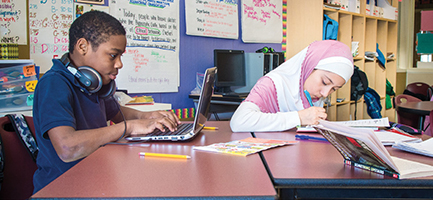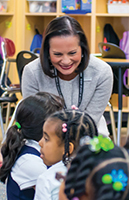A Blended Learning Journey
November 01, 2015

In 2008, Highline Public Schools in Washington surveyed households in preparation for a public bond measure during which we found almost 50 percent of families did not have Internet access. Over the years, as low-cost options have emerged, the number with home access has increased, yet there remains a digital divide in our schools that we consider inequitable and unfair.
Wanting to level the playing field for all students, three years ago we began to look to other school districts, notably Vancouver, Wash., and Mooresville, N.C. Those districts had begun providing students with personal technology devices and incorporating blended learning into their classrooms.
The first important lesson we learned was to be thoughtful, rather than rushed, in taking blended learning to scale. As a result, we developed a five-year plan for ensuring technology access across all schools and homes in the district.
We are intentional in not only documenting what we are learning, but also sharing and applying these practical ideas along the way.
An Ambitious Plan
Highline, located just south of Seattle, is a richly diverse district with 39 schools serving more than 19,000 students. Nearly 3,000 receive special education services, more than 4,000 speak a native language other than English and close to 14,000 qualify for free or reduced-price meals.
Believing in the ability of all students, in 2013 we adopted an ambitious four-year strategic plan that calls for eliminating the achievement gap through high-quality early learning; raising graduation rates by reducing out-of-school suspensions; and ensuring students pass algebra no later than 9th grade.
We also called out the need in our strategic plan for all Highline students by 2026 to graduate tech-savvy and tech-literate knowing how essential these skills are for success in college and career. This pursuit began in earnest with our launch of blended learning.
These are four lessons we learned about this process.
1. Begin with a vision for enhancing teaching and learning.
Technology amplifies, rather than supplants, effective teaching practices. By starting with what students need to know and be able to do, we leverage technology in service of those needs. This belief formed the basis for our blended learning vision.
Using all tools, digital and otherwise, and guided by data, we create learning environments that are student-centered, personalized and gap-closing. The classroom teacher is the facilitator of blended learning. The key is in the blend of instructional practices, data and tools.
We believe blended learning supports equitable instruction that ensures academic achievement and success for every student through:
- Data and feedback for all students to push their learning;
- Differentiation and personalization;
- Rigorous content instruction aligned to standards; and
- Engagement and agency for all students.
Having a vision that puts strong instructional practice front and center is key because teachers and staff new to this work sometimes focus too much on what the device or program is rather than how it can improve teaching and learning in their classrooms.

At Midway Elementary School, staff initially wanted iPads schoolwide. Fortunately, the principal and staff realized early in the adoption process that, while iPads were right for the primary grades, Chromebooks would be a better fit for their 5th and 6th graders. Students at all grade levels now have devices that best support their learning because staff focused on what students needed rather than what devices they wanted.
2. Gauge readiness and measure effectiveness.
Creating positive, technology-rich learning environments where students are engaged, motivated, supported and challenged requires strong leadership, staff who see themselves as both learners and teachers, and a commitment to using data for continuous improvement.
We knew from talking with colleagues in other school districts that going slow to go fast when making the blended learning transition is critical to success. For that reason, we began with a small pilot at two schools last year, Midway Elementary and Cascade Middle. The principals at both schools are strong instructional leaders who understand that collaboration with and among staff and families is essential.
These principals developed a schoolwide blended-learning strategy with their teachers that was ambitious but achievable, knowing that early wins would increase the level of confidence and excitement among families and community members. As a district, we now have a set of readiness questions that principals and their staffs answer before we make any commitments to blended learning.
In addition to identifying the readiness of staff members, we also carefully select, implement and monitor the effectiveness of our digital tools and programs. Central-office and school staff jointly research programs and evaluate them for impact on student learning. Criteria include:
- correlation and alignment between the program progress measures and external measurements such as our district benchmark assessments and state assessments;
- ability to provide personalized pathways, alignment with state standards including Common Core State Standards and Next Generation Science Standards; and
- ability of teachers to modify programs to align with district instructional materials and frameworks.
Once the digital tools are selected, central-office specialists design overview documents highlighting what student learning needs the program addresses and how to incorporate the program into our existing instructional models. This provides teachers with early ideas for integrating the program into their classroom without being overly proscriptive because we want our teachers to innovate and adapt technology to their students’ needs. By being intentional in how we introduce new digital tools and programs, we are accelerating and challenging students like never before, while at the same time encouraging our teachers to be creative learners and blended learning trailblazers.
3. Listen and learn from students and teachers.
Our teachers and students have become our best guides on this journey and have taught us some of our most important lessons.
Each of our pilot sites has a blended learning leadership team that develops the school’s strategy and identifies what support they will need from central office. These teams have identified targeted, collaborative professional learning and in-classroom coaching as the highest impact strategies for success.
At Midway Elementary School, staff members collaborated on a crosswalk document merging our instructional framework with the differentiated practices needed for effective blended learning. This document not only has been widely shared throughout Highline, but school districts across the country now use it as well.
What we learned from this is the need to provide teachers with opportunities to develop tools and share ideas with one another. This fall we will host our first-ever Tech 2 Teach Fair where teachers will take the lead in demonstrating their own successful practices and sharing what their students can now do as a result.
At Cascade Middle School, student ownership and feedback was instrumental to the first year’s success. Students at the school read about the challenges staff and students in the Los Angeles Unified School District faced during their iPad rollout and offered suggestions for how they could do better. As a result, students were first issued “paper” laptops to practice what it meant to take home, use and care for their own device 24 hours a day. It worked. At the end of last year, we had fewer than a handful of lost, damaged or stolen devices. Students took our investment and belief in them seriously and lived up to our high expectations for them. This fall we used student panels to build on this student-led success as we expand our rollout to other schools.
4. Engage families and community.
As with anything we do, engaging families and community is essential for our students’ success.
Through evening events, morning coffees and ongoing communication, we have kept families up to date on our work and provided opportunities to try out tools with their children. This takes time and tenacity because not all families can attend school events at the same time. Both Midway and Cascade hosted multiple events throughout the year to ensure a broad representation of families and community partners.
Still, the digital divide in Highline means not all students and families have online access. As such, we partnered with Syntonic, a mobile-platform service provider. This allows students to extend their learning at home and addresses the opportunity gaps brought about by income barriers. Data from our pilot schools indicate students are benefitting by accessing their math programs, collaborating with peers on Google Docs and submitting assignments remotely to their teachers. Additionally, we learned that this access is improving not just our students’ learning, but their families’ connectedness as well.
This year we are supporting at least three additional schools as they transform their classrooms through blended learning. We will continue to scale smartly and thoughtfully. By keeping our focus on strong instructional practice, the leadership of our teachers and principals, the power of our families and the voice of our students, we will deliver on our promise of knowing every student by name, strength and need and ensuring they graduate tech-savvy, tech-literate and prepared to shape their future and ours.
Advertisement
Advertisement
Advertisement
Advertisement



